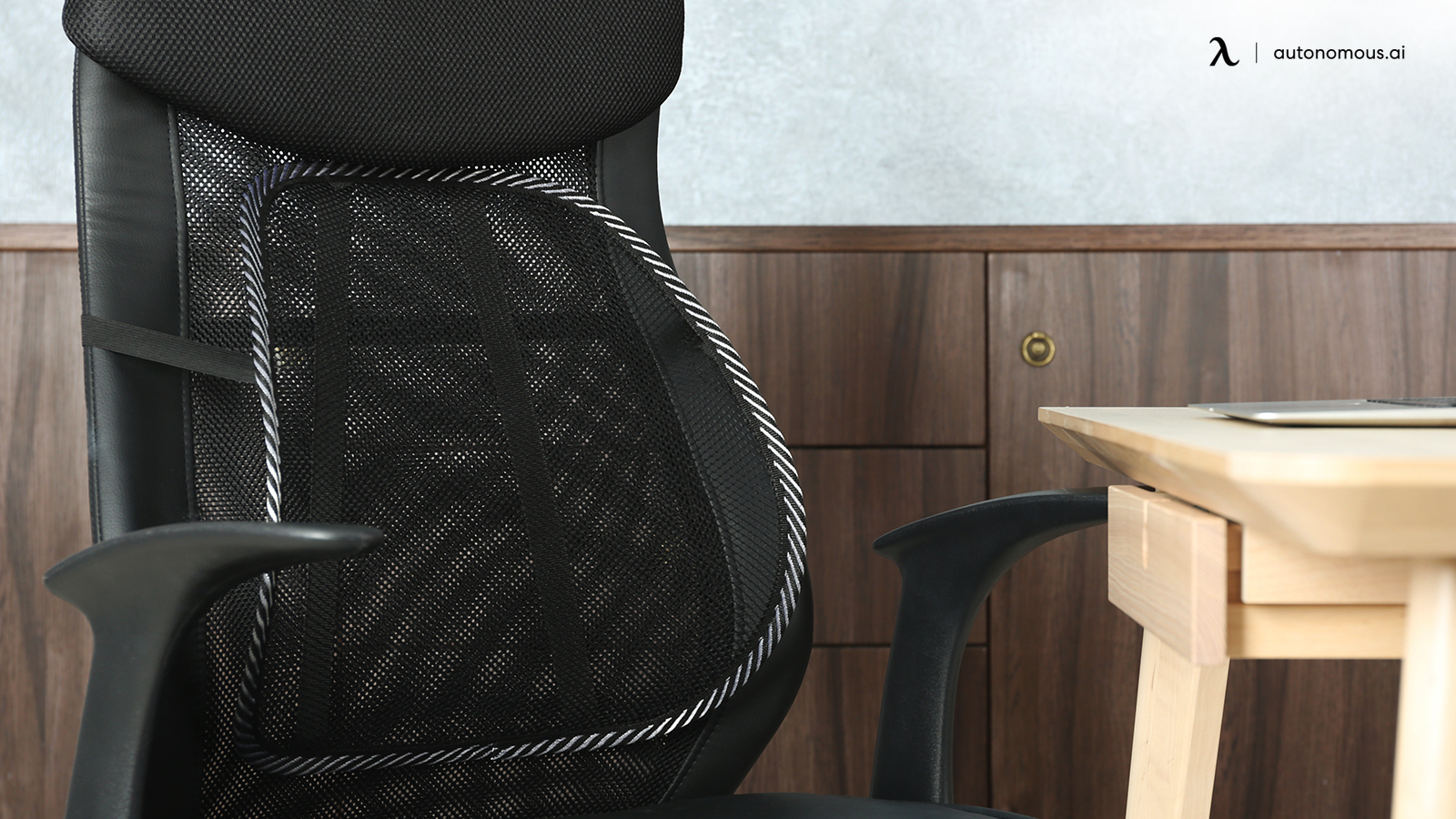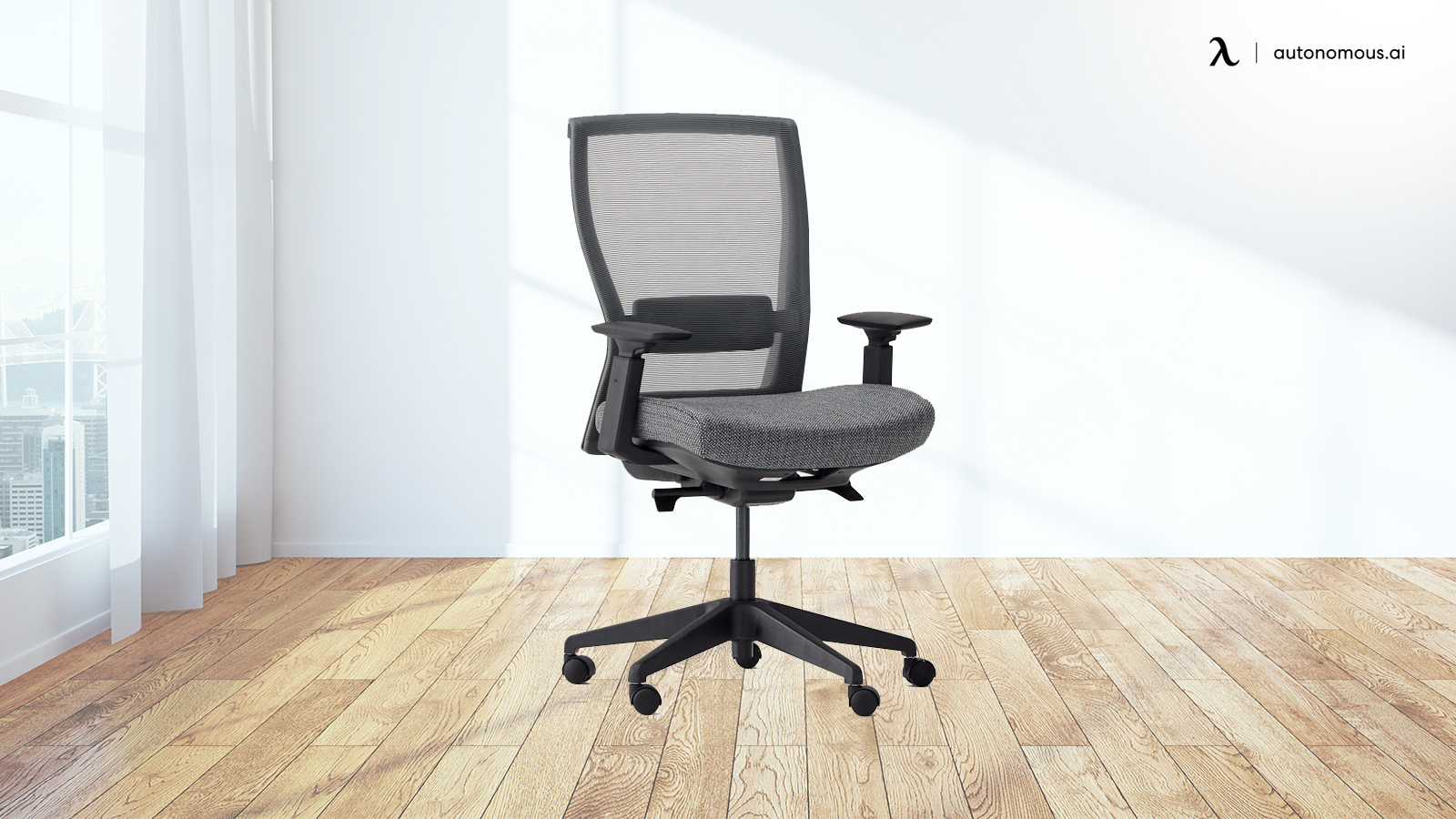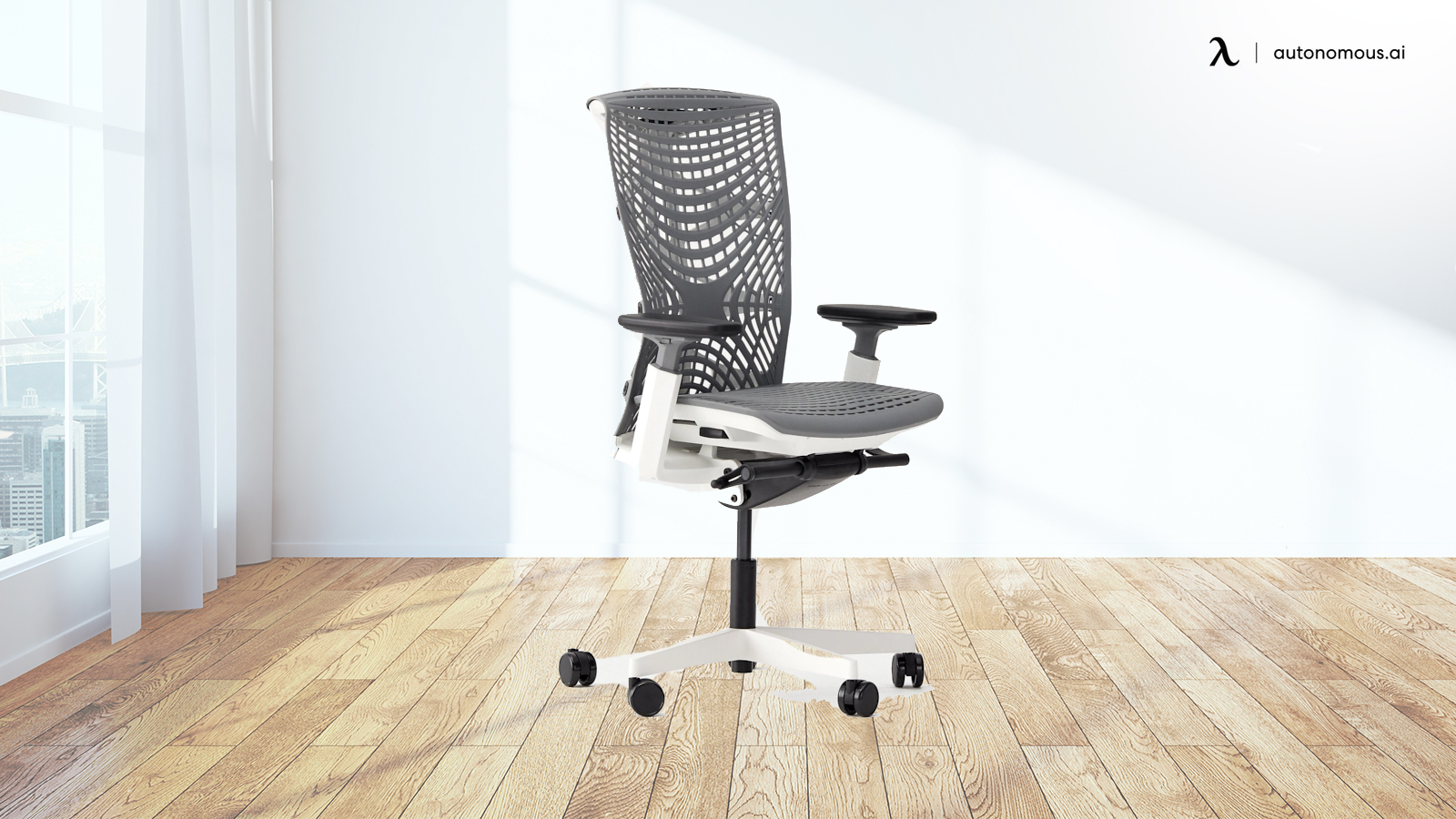/https://storage.googleapis.com/s3-autonomous-upgrade-3/static/upload/images/new_post/lumbar-pillows-vs-lumbar-support-chairs-pros-and-cons-849-1605776630597.jpg)
Lumbar Pillows vs Lumbar Support Chairs (Pros and Cons)
One of the most important ergonomic details of a modern office chair is lumbar support. Lumbar support is support for your lower and middle spine, allowing you to sit comfortably in a way that doesn’t put unnecessary pressure on parts of your spine. With proper support, the muscles in your back don’t need to tense to keep your back straight, so you’ll have less lower-back pain after a day at the office.
There are several different styles of lumbar support, so let’s break them down and get into the details.
Foam Lumbar Pillows
The first kind of lumbar support is the simple lumbar support pillow. Lumbar pillows are, well, pillows. They are designed to sit on your chair, between your lower back and the back of the chair, to give you lumbar support on a chair that otherwise does not have support for your lower back.

Foam lumbar pillows can be made up of simple pillow cotton, down, beads, or memory foam. They vary a lot in quality and longevity, and there are hundreds of not thousands of different designs on the market.
So, what are the pros and cons of these lumbar support pillows?
Pros:
- A wide variety of styles allow you to pick one that fits you the best. From small pillows that attach with a single strap to wider pillows with wings, round pillows, flat pillows, memory foam pillows; there are as many options as there are people who want one.
- Individual pillows are relatively small and easy to carry. You can use one pillow at home, use it in the car as you drive to work, use it in your chair at work, and bring it home again. If you need to move between the office desk and the meeting room, you can bring the pillow along with you.
- Once you find a pillow you like, you can use it with any chair that has a wide back. All a pillow asks for is enough of a back to the chair that it can be supported. Some pillows also have straps to keep them snugly in place, though others rely more on their size to be positioned properly.
- Simple lumbar pillows typically cost very little, especially compared to a new chair. Where a chair can run you anywhere from $200 to $2,000, a lumbar pillow is generally going to be under $50 for all but the fanciest and advanced pillows on the market.
- Some may have additional features, such as a built-in heating element. Sure, you need access to a plug to use these kinds of features, but they can help make your office work environment more comfortable in the cold and can help soothe existing back pain.
All that said, let’s look at the downsides to these lumbar pillows.
Cons:
- A wide variety of styles means you have to find one that fits you the best. If a pillow doesn’t fit your chair, isn’t adjustable to a position you want, or is too bulky (or not bulky enough), you need to find a different style and design that works better. It can take some time to dial into a pillow that works best for you.
- Some chair styles don’t work with a pillow. Chairs that have a narrow back post and a raised pad for a back, like many low-end office chairs and task chairs, don’t offer enough support to hold a pillow in place. It can slip from side to side, or slide back into the seat pan, and fail to provide you real lumbar support.
- Many lumbar pillows are made of cheap materials and will compress or degrade over time. Where a good chair can last you years without degrading, a simple lumbar pillow might not even make it to a year of constant use. Higher quality memory foam pillows last longer, but they can still degrade over time.
- Pillows can be difficult to adjust to different chair sizes and styles. Depending on the kind of straps or design they use to secure to a chair, it can be tricky to adjust them for different styles of chairs; they work best if you’re always using one chair (in which case, why not get a chair with built-in support?) or when you’re moving between multiple of the same kind of chair.
Is a pillow the right choice for you? It’s an option, certainly, but there are other options available to you as well.
Rigid Lumbar Supports
Rigid lumbar supports are a sort of half-way point between a lumbar pillow and a chair. They’re usually folding devices with a padded seat and a padded back that offers lumbar support. They don’t have arms and they don’t have legs or a wheelbase, because they’re meant to sit on and accentuate your existing chair. They’re similar in design to a stadium seat, which is meant to attach to a stadium bleacher bench to offer back support.

Like lumbar pillows, rigid lumbar support seats come in a variety of different designs and quality levels, though they’re not as common as lumbar pillows.
Pros:
- The built-in back means they work with any chair. Unlike a simple pillow, rigid lumbar support sits on the seat pan and provides its own back, held in place with your weight. Some may latch down to the seat pan or strap to the back of your chair as well for additional rigidity.
- They tend to be better designed and built than pillows alone and are more durable. Their frame means they won’t slip out of place, and the cushioning is generally higher quality and better positioned than a pillow that can move and compress over time. That said, not all rigid supports are that high quality.
- Some designs may have additional features, such as heating or massagers. This can make your overall work environment significantly more comfortable, though some such designs can lack real lumbar support, so make sure the one you aim to buy has both.
Cons:
- Rigid supports are larger and bulkier than pillows, and thus harder to move from place to place. They’re still portable, just not AS portable as a smaller pillow.
- Rigid construction means they don’t always fit right on every style of chair. In particular, chairs with narrow arms might be too narrow for wide support.
- A larger and more complex design means they’re more expensive and are thus more expensive to replace when they degrade. They’re generally not as well-constructed as a chair and will need replacing long before a chair would.
- Because they’re like another chair on top of a chair, the rest of the chair needs to be adjusted to fit. The additional height means you need to lower your chair and potentially raise your keyboard and monitor for the best ergonomic positioning.
Adjustable Lumbar Chair Supports
The previous two kinds of lumbar support are both items you buy and add to a simple chair, like a task chair, that has no lumbar support of its own. The second two kinds of lumbar support are features built into a chair, instead.
First, we have adjustable pillow-style supports. These can come in a few different varieties. Some chairs essentially come with a lumbar pillow attached to them, which can be moved up and down within a limited range of motion. Many gaming chairs offer this kind of pillow, attached with a strap that is threaded through purpose-built holes in the design of the chair itself.

The other style of adjustable lumbar supports is a lumbar pad attached to the chair, often behind the mesh of the back. This is featured in the MyoChair and other mesh-backed office chairs, for example. This lumbar support is built into the chair and can be adjusted up and down as well as in and out to provide the optimal level of support.
Pros:
- Built-in support can be adjusted to your needs and stays where it needs to be. You can adjust your chair to perfectly suit your office workflow, with proper ergonomic support, and leave it where it is.
- Depending on the style, the lumbar support may be replaceable if it degrades over time. Some chairs have removable lumbar support pads, and while ordering a replacement might not be as easy as ordering a new pillow, it’s better than buying a new chair.
Cons:
- Because it’s built into the chair, your range of adjustment may be limited. Some don’t move much at all, some can only adjust up and down, and some have a full range of movement. It varies a lot.
- You can’t transport your lumbar support from one chair to another. Even if the lumbar support is removable, it’s designed to work with that one chair, and likely won’t be compatible with (or even attachable to) the other chair.
Built-In Lumbar Support
The final style of lumbar support is the most common and perhaps the most widely varied of all of them, and that is the built-in lumbar-supporting design. High-end, expensive chairs like the Embody or the more affordable Kinn Chair, for example, use multiple dynamic points of resistance to create a spine-cradling back without needing to manually adjust a lumbar supporting pad. Conversely, many low-to-mid-range designs of chair offer a curved back meant to contour to the spine, but do not offer adjustable or dynamic support. They’re a sort of one-size-fits-all form of spine support.

This style of lumbar support varies the most in terms of quality. At the low end, it can offer some spinal support, but it might not fit your back if you have a larger degree of curvature, existing back pain issues, or if you’re taller or shorter than average. At the high end, it can be very comfortable and very beneficial to your posture and overall well-being, but these can get expensive.
Pros:
- Built-in design is generally engineered for the best level of seamless support without the press of an individual pressure point. You get a full-back cradling support with your chair, often automatically.
- The high-quality design doesn’t generally stretch or compress as much so it doesn’t need constant adjustment or replacement. Your chair just works when you sit in it, and you don’t need to manually adjust the lumbar support at all.
Cons:
- Built-in design means if the support wears out, it’s time for a new chair, which can be expensive (especially compared to buying a new pillow). This is especially true for chairs where the support is the tension of the mesh back itself.
- Low-end designs may not be suitable for all body types. Simple chairs with curved backs work for the “average” person, so if your body type is outside of that typical average range (larger or smaller) the chair will be uncomfortable.
- Cannot be moved from chair to chair. The support IS the chair itself, so it cannot be moved from one to another, you need to move the whole chair.
Wrapping Up
Overall, lumbar support is incredibly important, but it can be achieved in a wide variety of different ways. There’s no one “right answer” for everyone; the choice you make depends on the kind of chairs you use and your lifestyle while working.
For example, if you work in an office environment where desks and chairs are “hot swap” and first-come, first-served, bringing your own pillow you can use may prove to be the best idea. You don’t have a chair that is “yours” in this scenario, so you want customization that you can move from place to place. Unless, of course, your employer has provided ergonomic chairs with built-in lumbar support for everyone.
If you have one dedicated workstation with a desk and chair that are your own to control, you will generally find it a better, more comfortable fit to buy a high-quality chair like the Kinn or the ErgoChair 2, which you can adjust to fit your body and never need to worry about again.
If you’re ordering chairs for your office and you’re wondering what the best option is, look for a chair with either built-in lumbar support or adjustable lumbar support that isn’t just a removable pillow. Your employees will thank you.
Subscribe for a 10% discount on your first order.
Sign up for our weekly update and be the first to know about our specials & promotions.

/https://storage.googleapis.com/s3-autonomous-upgrade-3/production/ecm/240417/april-10-off-offer-2024-1920x540-CTA.jpg)
/https://storage.googleapis.com/s3-autonomous-upgrade-3/production/ecm/240417/april-10-off-offer-2024-720x1200-CTA.jpg)
/https://storage.googleapis.com/s3-autonomous-upgrade-3/production/ecm/240415/bulk-order-apr-2024-offer-720x1200-CTA-min.jpg)

/https://storage.googleapis.com/s3-autonomous-upgrade-3/static/upload/images/new_post_author/admin-1.png)